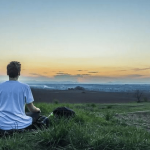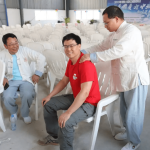太极 massage (tui na) combines the experience of predecessors, using Tai Chi thinking and Wudang Tai Chi Chuan as the clinical foundation of “guarding the form” 和 “guarding the spirit.” It summarizes the essence of Tuina into sixteen characters: “soft, 深的, wide, thick, relaxed, skillful, penetrating, smooth, refined, thoughtful, intentional, perceptive, elegant, rhythmic, guarded, and ultimate,” encapsulating the exquisite Tuina techniques both in form and spirit.
What is Tai Chi Massage (tui na)?
Tai Chi massage (tui na) is not a simple concept, it involves applying the principles of Tai Chi to traditional Tuina massage, which sets relatively high standards.
- A good Tai Chi massage therapist should breathe naturally, stay relaxed, and maintain a light and graceful posture and footwork during the procedure. They should have a clear mental image of the anatomical structures under their hands.
- The practice should be thoughtful, content-rich, wise, and rhythmically coherent, with a clear beginning and end, and a sense of elasticity, 力量, and emphasis.
- The techniques can sometimes be as calm as a lake, sometimes as majestic as the sea, sometimes as delicate as silk, and sometimes reach a climax like an artist performing a beautiful symphony.
- It flows continuously like clouds and water, with a strong therapeutic desire guiding the patient’s thoughts along with the movement of the hands.
- This powerful, 深的, and regionally distinctive technique is known as “Tai Chi massage or Tai Chi Tuina.”
太极按摩 (tui na) vs Traditional Chinese Massage
In modern rehabilitation therapy, commonly used techniques include physical therapy, occupational therapy, speech therapy, psychological counseling and therapy, recreational therapy, traditional Chinese treatments, rehabilitation engineering, rehabilitation nursing, and social services. Among these, physical therapy is the most important and frequently used functional training method in rehabilitation. Tai Chi massage tuina, compared to traditional Chinese Tuina techniques, has unique advantages in physical therapy:
Guided by Intention, Continuous and Rounded Movements:
- Tai Chi Tuina techniques use the mind to guide the force, creating continuous and smooth movements.
- The practitioner maintains an upright posture, broad chest, solid abdomen, natural breathing, and concentrated spirit.
- By using intention to guide the breath, the force is generated from the waist and spine, manifested through the hands, achieving the unity of intention, 呼吸, and force.
- Movements are natural and smooth, with continuous and uninterrupted force that penetrates the skin and reaches the acupoints and meridians. The transitions between techniques are natural, flexible, and coherent.
Combining Softness and Strength:
- During the technique, the practitioner is focused, highly concentrated, and mentally calm, dedicating their full attention to the massage treatment.
- According to the patient’s condition, the practitioner selects appropriate techniques and adjusts the force and speed based on the patient’s response.
- This balance of softness and strength achieves the best therapeutic effect, combining rigidity with flexibility.
Light, Steady, Relaxed, and Deep:
- The practitioner’s demeanor is relaxed, movements are natural and smooth, neither too fast nor too slow, and the technique is orderly.
- The practitioner maintains a relaxed mind and body, with an outwardly tight but inwardly loose posture, using subtle techniques to achieve significant effects.
- These characteristics are unique to Tai Chi Tuina and are not found in traditional Chinese Tuina techniques.
Additionally, the development of Tai Chi massage Tuina requires the support of modern rehabilitation medicine.
Rehabilitation diagnosis (assessment) is a crucial component of modern clinical rehabilitation. Tai Chi Tuina, as a form of rehabilitation massage, begins and ends with evaluation. Therefore, in clinical practice, a comprehensive and accurate rehabilitation assessment is necessary before performing Tai Chi Tuina techniques.
After the patient’s phase-specific treatment ends, timely rehabilitation assessments are also needed to provide feedback and evaluate the effectiveness of the techniques used.
How to do Tai Chi massage (tui na) ?
The Tai Chi Massage technique is a method that combines traditional Chinese Tai Chi principles with massage. It emphasizes synchronization with breathing and uses gentle movements to promote health and recovery. Here are several steps involved in the Tai Chi Massage Technique:
- Preparation Phase: 第一的, ensure that the body is warm by rubbing the hands together or warming them beforehand. Relax the body, either by lying down or sitting comfortably. Place the palms gently on the abdomen (at the Shenque acupoint) and feel the rhythm of breathing.
- Operational Phase: With the rhythm of breathing, maintain consistent hand movements with the rising and falling of the abdomen. As you inhale, let the abdomen rise, gently lifting the hands; as you exhale, let the abdomen fall, gently lowering the hands. Avoid excessive force during operation to maintain the rhythm of breathing.
- Observation and Adjustment Phase: During the massage, observe whether the recipient’s breathing becomes regular and deep and whether there are intestinal movements (rumbling sounds). If these reactions occur, continue the massage for 10 to 30 minutes. If the response is slow, continue the massage until half an hour constitutes one treatment session. In the treatment of severe illnesses, the duration and frequency of massage may increase.

The benefits of Tai Chi Massage (tui na)
Improving Sleep
Tai Chi massage can help improve the quality of sleep. The massage techniques of Tai Chi massage can relax the body’s tension, promote blood circulation, and regulate the body’s internal biological clock, thus improving sleep quality.
Effects of Tai Chi Massage (太极按摩: Relieving Fatigue, Promoting Blood Circulation)
Relieving Fatigue
Tai Chi massage can reduce feelings of fatigue in the body. The massage techniques of Tai Chi massage can promote blood circulation, and accelerate metabolism, thereby reducing feelings of fatigue and making one feel more energized.
Relieving Stress
Tai Chi massage can relieve both physical and psychological stress. The massage techniques of Tai Chi massage can alleviate the body’s tension, promote blood circulation, and regulate the body’s internal biological clock, thus relieving physical and psychological stress.
Promoting Blood Circulation
Tai Chi massage can promote blood circulation in the body. The massage techniques of Tai Chi massage can stimulate the body’s meridians and acupoints, enhance blood vessel elasticity, and promote blood circulation, thereby achieving various effects such as soothing the body and enhancing immunity.
Enhancing Immunity
Tai Chi massage can strengthen the body’s immunity. The massage techniques of Tai Chi massage can stimulate the body’s meridians and acupoints, promote blood circulation, and enhance the body’s immunity, thereby preventing and treating various diseases.
Regulating Endocrine System
Tai Chi massage can regulate the body’s endocrine system. The massage techniques of Tai Chi massage can stimulate the body’s meridians and acupoints, and regulate the body’s internal biological clock, thereby achieving various effects such as regulating endocrine function and balancing body functions.
Improving Digestive System
Tai Chi massage can improve the body’s digestive system. The massage techniques of Tai Chi massage can stimulate the body’s meridians and acupoints, promote metabolism, and improve the body’s digestive system, thereby preventing and treating various digestive system diseases.
Preventing and Treating Diseases
Tai Chi massage can prevent and treat various diseases. The massage techniques of Tai Chi massage can stimulate the body’s meridians and acupoints, promote blood circulation, enhance immunity, regulate the body’s endocrine system, and more, thereby preventing and treating various diseases.
教程视频
Tai Chi Foot Massage
For us humans, the health of our internal organs is essential for overall body health. Since these organs are inside our bodies, the most “direct” way to maintain their health is by stimulating their “reflex zones” on the body’s surface.
We have two important reflex zones: the ears and the feet. The ears resemble an inverted fetus, encompassing all the internal organs. Our feet are similar in this regard. However, there’s a key difference: once we get out of bed, our feet start working, bearing our entire body weight throughout the day while we stand and move around.
Tai Chi foot massage applies the principles and techniques of Tai Chi to foot massage. This combination offers numerous benefits for our bodies and can help a tired body recover quickly.


